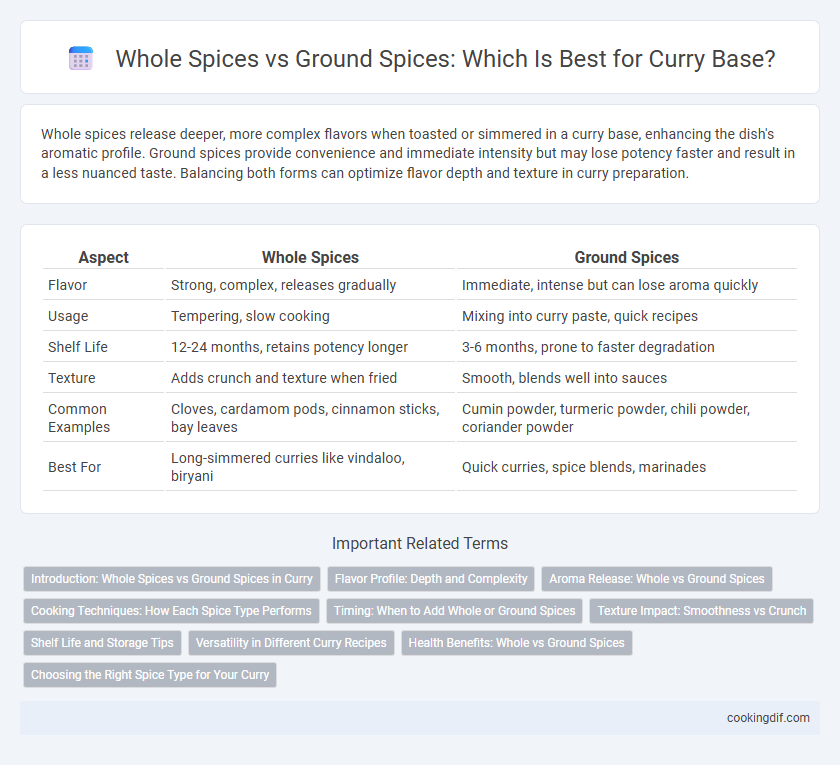Whole spices release deeper, more complex flavors when toasted or simmered in a curry base, enhancing the dish's aromatic profile. Ground spices provide convenience and immediate intensity but may lose potency faster and result in a less nuanced taste. Balancing both forms can optimize flavor depth and texture in curry preparation.
Table of Comparison
| Aspect | Whole Spices | Ground Spices |
|---|---|---|
| Flavor | Strong, complex, releases gradually | Immediate, intense but can lose aroma quickly |
| Usage | Tempering, slow cooking | Mixing into curry paste, quick recipes |
| Shelf Life | 12-24 months, retains potency longer | 3-6 months, prone to faster degradation |
| Texture | Adds crunch and texture when fried | Smooth, blends well into sauces |
| Common Examples | Cloves, cardamom pods, cinnamon sticks, bay leaves | Cumin powder, turmeric powder, chili powder, coriander powder |
| Best For | Long-simmered curries like vindaloo, biryani | Quick curries, spice blends, marinades |
Introduction: Whole Spices vs Ground Spices in Curry
Whole spices such as cumin seeds, cinnamon sticks, and cardamom pods provide complex, robust flavors when toasted in curry bases, releasing essential oils that enhance depth and aroma. Ground spices offer convenience and quick infusion, ideal for smoother curry textures and consistent seasoning throughout the dish. Choosing between whole and ground spices depends on the desired flavor intensity, cooking method, and authenticity of the curry recipe.
Flavor Profile: Depth and Complexity
Whole spices in curry bases release essential oils gradually during cooking, enhancing the depth and complexity of the flavor profile with rich, layered aromas. Ground spices provide immediate intensity but can lack the nuanced, evolving taste that whole spices impart as they toast and infuse. Using whole spices ensures a more dynamic and vibrant curry, elevating both fragrance and taste complexity in the final dish.
Aroma Release: Whole vs Ground Spices
Whole spices release aroma gradually during cooking, infusing curry bases with a deep, complex fragrance that develops over time. Ground spices provide an immediate burst of aroma, quickly enhancing the flavor but often losing their potency faster during prolonged cooking. Selecting whole spices ensures a layered, lasting aroma while ground spices are ideal for quick, intense flavor boosts in curry preparation.
Cooking Techniques: How Each Spice Type Performs
Whole spices release flavors gradually when toasted or simmered, infusing curries with a deep, complex aroma over time. Ground spices dissolve quickly, providing an immediate, intense flavor but can lose potency if cooked too long or exposed to excessive heat. Using whole spices at the start and ground spices later ensures balanced flavor extraction and optimal taste in curry bases.
Timing: When to Add Whole or Ground Spices
Whole spices for curry are best added early in the cooking process to allow their flavors to fully infuse the oil and develop depth. Ground spices should be stirred in later, often after sauteing onions and other base ingredients, to prevent burning and ensure their aroma remains vibrant. Timing the addition of whole and ground spices precisely enhances the curry's complexity and balance.
Texture Impact: Smoothness vs Crunch
Whole spices in curry bases provide a distinct texture impact by releasing bursts of flavor and a subtle crunch that enhances mouthfeel, contrasting the uniform smoothness achieved with ground spices. Ground spices create a consistent, velvety texture that blends seamlessly into the curry, offering a rich, homogenous base without interruptions in bite. Choosing between whole and ground spices influences the curry's sensory experience, balancing between textured complexity and smooth flavor integration.
Shelf Life and Storage Tips
Whole spices for curry base offer a longer shelf life, typically retaining potency for up to 3-4 years when stored in an airtight container away from heat and light. Ground spices tend to lose flavor faster, usually within 6 months to a year, due to increased surface area exposure to air and moisture. Proper storage in cool, dark places and using airtight containers is essential to maximize freshness and maintain the rich aroma and taste of curry spices.
Versatility in Different Curry Recipes
Whole spices offer greater versatility by releasing flavors gradually during cooking, enhancing complex curry bases such as Indian garam masala or Thai red curry pastes. Ground spices provide immediate, intense flavors ideal for quick recipes like butter chicken or korma, but may lose aroma faster than whole seeds like cumin, cardamom, and coriander. Using a combination of whole and ground spices allows chefs to balance depth and immediacy in diverse curry preparations, optimizing texture and taste.
Health Benefits: Whole vs Ground Spices
Whole spices used in curry bases retain essential oils and antioxidants longer, leading to enhanced health benefits such as improved digestion and anti-inflammatory properties. Ground spices tend to lose potency and nutritional value faster due to increased surface area exposure to air and light. Incorporating whole spices in curry preparation maximizes the bioactive compounds that support immune health and metabolic function.
Choosing the Right Spice Type for Your Curry
Whole spices such as cinnamon sticks, cardamom pods, and cloves release intense, layered flavors when toasted or simmered, making them ideal for slow-cooked curry bases. Ground spices like turmeric, coriander, and cumin provide immediate, uniform heat and color, perfect for quick curries or when a smooth texture is desired. Selecting the right spice type depends on the cooking method and flavor depth you want, with whole spices enhancing aroma and complexity, while ground spices deliver fast, consistent taste.
Whole Spices vs Ground Spices for curry base Infographic

 cookingdif.com
cookingdif.com